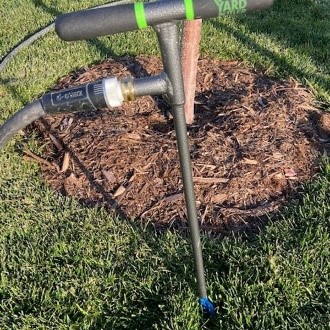Rings, Donuts, Diapers and Bags. How To Really Water A Tree.
- 2022-11-06
- By mkirk
- Posted in Horticulture, The Garden Buzz
By Donnetta Wilhelm, Colorado Master Gardener
Purdue University states tree dormancy can be divided into three phases: early rest, winter rest, and after-rest. Each of these phases has a specific physiological process that helps keep the tree’s living cells unfrozen and active, but on a reduced level that still allows the tree to survive freezing temperatures. Keeping the cells hydrated during winter months is critical to each of these phases, as well as to long-term tree health. If a tree cannot find the needed water due to drying winds, no snow cover, and warm days, expect poor health and a stressed tree the following spring. What is the best way to hydrate trees during winter months?
Tree Irrigators: Rings and Donuts

Search big box stores, garden centers, and the internet, and a variety of watering gadgets can be found. It is easy to fall prey to many of these because they can simply be filled with water and the human can walk away. Yay, a time-saver! But do they work? Yes…and no. Certainly any method of providing water to a tree might be considered good. However, there is a common saying: roots grow where there is water. If these gadgets only water in the 1- to 2-foot radius away from the tree base (known as the root ball), that is where the roots will grow. This causes the deadly condition known as girdling roots.
Tree Irrigators: Diapers and Bags

For the same reason as watering rings and donuts, tree diapers and bags also irrigate the small radius of the root ball. These contraptions have pockets that get filled with water, then irrigate via slow leak. The moisture pocket of the bag covers the trunks of trees creating a dark and damp environment that does not allow for air flow or light exposure which is damaging to the bark of a tree. It also creates the perfect environment for pests and disease to thrive. These bags also need to be filled frequently with water. Driving down a street one day, I noticed tree after tree with these watering bags. I stopped and checked many of them. Yep, every single one was empty, and the soil of each root ball was bone dry, so I’m not certain what these were accomplishing.

Trees need water at their driplines – where tree roots extend to the outermost branch tips and in the top 12-18 inches of soil. During the winter months (Oct-Mar), water can be applied on the surface using most types of hose-end sprinklers. However, the most effective watering device is the deep root watering needle. This provides water directly to the root system and is the most efficient at saving water. Winter water trees by inserting the deep root watering needle into the soil about 8-10 inches, then slowly turn on the hose. Water times depend on the diameter of the tree trunk. Continue to water around the dripline moving the watering needle every few feet.

The deep root watering needle method is the most effective way to hydrate your trees during the dry winter months. Keeping trees healthy and strong is vital for them to thrive in our harsh environment. Correctly watering them is an important part of a healthy root system so they can flourish in the landscape. CSU offers excellent information on winter watering.
Horticulture Resources
- Garden Buzz Archives
- CSU Extension Resources
- Colorado Master Gardener Program
- Foothills to Plains Native Plant Master Program
- Native Bee Watch Community Science Program
- The Co-Hort Blog
- PlantTalk Colorado
- Soil Testing
- Plant Select
- Emerald Ash Borer
- Japanese Beetle
- Colorado State Forest Service
- Ask an Expert


